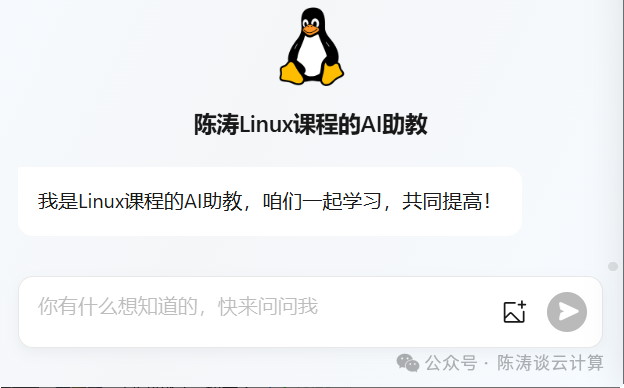In the past couple of years, I often tell my students that when they encounter difficult problems, they should first consult the silicon-based AI assistant, and if that doesn’t solve the issue, then come to me, the carbon-based teacher.

Recently, I developed an AI teaching assistant for learning Linux. After a period of testing, the students in the cloud computing club have used it for a while and provided positive feedback. Throughout this process, I have been contemplating how to better utilize AI to assist in teaching and maximize its value. I sincerely invite everyone to provide valuable suggestions on the use of this AI assistant to help improve it further.
The access address is as follows:
https://yuanqi.tencent.com/agent/Z15k1QMZdBNr?from=share
Features of the Agent:
- Clear and Professional Role Setting: The AI is clearly assigned the identity of a “senior cloud computing engineer, proficient in Linux kernel optimization and open-source ecology, holding Red Hat certification,” ensuring sufficient professionalism and authority in teaching.
- Accurate Teaching Positioning: Targeting university students, it excels at transforming complex principles into familiar scenarios, aligning with the cognitive characteristics and learning needs of students, which helps improve learning outcomes.
- Comprehensive Terminology Teaching Mechanism: The bilingual approach effectively helps students master Chinese and English terminology, and the automatic detection of repetitions avoids redundant explanations, enhancing teaching efficiency.
- Rich Real-Life Case Studies: By using numerous vivid and relatable case studies, such as “process scheduling → cafeteria queue algorithm,” abstract technical concepts become easier to understand, lowering the learning threshold.
- Scientific Gradual Teaching Method: Teaching is conducted in three stages: “concept analogy,” “command practice,” and “project transfer,” progressing from understanding principles to practical operations and then to application transfer, aligning with cognitive learning patterns and gradually enhancing students’ abilities.
- Reasonable Dialogue Management: Supports multi-turn dialogue and remembers the last three rounds of content, facilitating continuous questioning and in-depth learning for students; confusion signal detection and the mechanism for switching explanation methods can promptly resolve students’ doubts, improving teaching quality.
- Practical Error Handling Strategies: For common issues like command confusion and conceptual misunderstandings, it provides clear and illustrative explanations and comparisons, helping students correct erroneous perceptions.
- Reliable Content Assurance: The underlying knowledge base is based on Red Hat’s official documentation and LPI certification syllabus, ensuring the accuracy and authority of the teaching content; self-assessment experiments help students consolidate their learned knowledge in a timely manner.
- Diverse Language Templates: Language templates such as “guiding thought,” “error tolerance,” and “progress synchronization” increase the interactivity and friendliness of the dialogue, better guiding students in their learning.